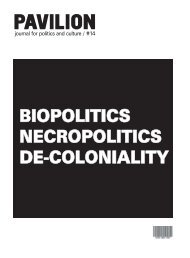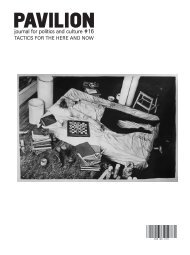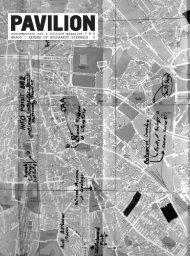PAVILION
PAVILION
PAVILION
- No tags were found...
You also want an ePaper? Increase the reach of your titles
YUMPU automatically turns print PDFs into web optimized ePapers that Google loves.
Notes<br />
1. Walter Benjamin, The Arcades Project, trans.<br />
Howard Eiland and Kevin McLaughlin, Harvard<br />
University Press, Cambridge MA and London,<br />
1999, p. 465 [N 4a, 2,].<br />
2. ‘The West’ is, of course, a historically constituted<br />
geo-political category, rather than simply<br />
geographical one. It spatializes a set of powerrelations<br />
between the dominant Euro-American<br />
powers and ‘the rest’, and thus signifies different<br />
spatial unities according to its historical and<br />
political context. For example, it was until<br />
recently used to exclude ‘Eastern’ Europe -<br />
despite its being part of Europe - while including<br />
Japan. See, Stuart Hall, ‘The West-and-the-<br />
Rest: Discourse and Power’, in Stuart Hall et al,<br />
eds, Modernity, Blackwell, Oxford, 1996, pp.<br />
184-227; and Naoki Sakai, ‘Dislocation of the<br />
West and the Status of the Humanities’, Traces<br />
1: Specters of the West and the Politics of<br />
Translation, edited by Naoki Sakai and Yukiko<br />
Hanawa, Traces, Ithaca, 2000, pp. 71-94. Since<br />
1989, there has been a tendency to try to draw<br />
the line within so-called ‘eastern’ Europe itself:<br />
instituting a competition of economic-ideological<br />
conformity to become part of ‘the West’.<br />
Meanwhile, Japan ponders the benefits of decoupling,<br />
with the prospect of a new East Asian<br />
bloc raising the spectre of an inverted (Chineseled)<br />
revival of the idea of a Greater East Asian<br />
Co-Prosperity Sphere, once central to the spatial<br />
imaginary of Japanese fascism.<br />
3. See, Peter Osborne, ‘Radicalism and<br />
Philosophy’, Radical Philosophy 103<br />
(September/ October 2000), pp. 6-11;<br />
‘Modernisms and Mediations’, in F. Halsall, J.<br />
Jansen, T. O’Connor (eds), Rediscovering<br />
Aesthetics: Transdisciplinary Voices from Art<br />
History, Philosophy and Art Practice, Stanford<br />
University Press, Stanford, pp. 163-177; and<br />
‘Modernism and Philosophy’, in P. Brooker et al<br />
(eds), The Oxford Handbook on Modernism,<br />
Oxford University Press, Oxford, Ch. 20, forthcoming<br />
2010.<br />
4. The landmark exhibitions here were the 1936<br />
‘Cubism and Abstract Art’ show, with Alfred H.<br />
Barr’s famous stylistic flowchart on the cover of<br />
the catalogue, terminating in just two streams<br />
(‘Geometrical’ and ‘Non-Geometrical’ Abstract<br />
Art) and the Bauhaus show of 1938. The subsequent<br />
claim for the US inheritance of the<br />
European tradition (explicit in Greenberg, for<br />
example) was, of course, not just a national<br />
claim, but a wider ideological claim about the<br />
USA’s leadership of the ‘free’ world during the<br />
Cold War. See Serge Guilbaut, How New York<br />
Stole the Idea of Modern Art: Abstract<br />
Expressionism, Freedom, and the Cold War,<br />
University of Chicago Press, Chicago, 1983.<br />
5. See the critical history of the lineages of<br />
negation at work here outlined in the ‘Survey’<br />
essay in Peter Osborne, Conceptual Art,<br />
Phaidon, London, 2002, pp. 12-51.<br />
6. See Peter Osborne, ‘Art Beyond Aesthetics:<br />
Philosophical Criticism, Art History and<br />
Contemporary Art’, Art History, Vol. 27, no. 4<br />
(September 2004), pp. 651-70 - reprinted in<br />
Deborah Cherry (ed.), Art: History: Visual:<br />
Culture, Blackwell, Oxford, 2005, pp. 171-190.<br />
7. See Thomas Crow, The Rise of the Sixties:<br />
American and European Art in the Era of<br />
Dissent 1955-69, Everyman Art Library,<br />
London, 1996.<br />
8. The origins of this victory date back to a different<br />
‘9/11’, 11 September 1973: the assassination<br />
of Allende, the socialist President of<br />
Chile, and the delivery of the Chilean economy<br />
to the so-called ‘Chicago boys’ - the group of<br />
neo-liberal economists gathered around Milton<br />
Friedman at the University of Chicago. See<br />
David Harvey, A Brief History of Neo-Liberalism,<br />
Oxford University Press, 2005.<br />
9. For the effects in an expanded Europe, see<br />
Barbara Vanderlinden and Elena Filipovic (eds),<br />
The Manifesta Decade: Debates on<br />
Contemporary Art Exhibitions and Biennals in<br />
Post-Wall Europe, Roomade/MIT Press,<br />
Cambridge MA, 2005. For an early attempt at a<br />
documentation of post-89 eastern European<br />
art, see Irwin (ed.), East Art Map: Contemporary<br />
Art and Eastern Europe, Afterall Books,<br />
London, 2006.<br />
10. Peter Burger, Theory of the Avant-Garde,<br />
trans. Michael Shaw, University of Minnesota<br />
pres, Minneapolis, 1984.<br />
11. See Peter Osborne, ‘The Power of<br />
Assembly: Art, World, Industry’, in Zones of<br />
Contact: Catalogue of the 2006 Biennale of<br />
Sydney, Sydney, 2006.<br />
12. Theodor W. Adorno, Aesthetic Theory<br />
(1970), trans. Robert Hullot-Kentor, University<br />
of Minnesota Press, Minneapolis, 1997 , p. 24.<br />
13. Cf. Alfred Schmidt, History and Structure:<br />
An Essay on Hegelian-Marxist and Structuralist<br />
Theories of History (1971), trans. Jefffrey Herf,<br />
MIT Press, Cambridge MA and London, 1981,<br />
which identifies the need for a ‘determinate<br />
negation of the structuralist negation of history’<br />
(p. 108).<br />
14. This notion of ‘becomings- and ceasings-tobe-ontological’<br />
is to be distinguished from the<br />
generic becomings of Deleuze and Guattari’s<br />
cyclical territorializations, de-teritorializations<br />
and re-territorializations, which take place on a<br />
single ontological plane, characterized by repetition,<br />
and thus acquire determinacy only empirically,<br />
and retrospectively. As such, their theorization<br />
lacks determinacy in its futural dimension,<br />
in principle.<br />
15. The word ‘determination’ is liable to generate<br />
confusion in English-language theoretical<br />
discourse, because of the history of its use to<br />
refer to the process of causation. I use it here in<br />
the philosophical sense of its German equivalent<br />
(Bestimmung), in the idealist tradition, to<br />
refer to a process of giving conceptual or<br />
semantic determinacy to something (i.e. to particularization).<br />
Failure to distinguish between<br />
these two senses has created a long history of<br />
misunderstandings in the relations between<br />
these two traditions. It is in the sense in which I<br />
use it here that, for example, Hegel wrote in the<br />
Preface to the 2nd edition of his Encyclopedia<br />
(1827) not only that the reader would find many<br />
parts of the book ‘developed into more detailed<br />
determinations (Bestimmungen)’, but also that<br />
the new edition had ‘the same vocation<br />
(dieselbe Bestimmung)’ as the first one. G.W.F.<br />
Hegel, The Encyclopedia Logic, trans. T.F.<br />
Geraets, W.A. Suchting, and H.S. Harris,<br />
Hackett, Indianapolis/Cambridge, 1991, p. 4. In<br />
a similar sense, Marx wrote in the Introduction<br />
to the Grundrisse (1857) of ‘the concrete’ as,<br />
methodologically, a result: ‘the concentration of<br />
many determinations, hence unity of the<br />
diverse’. Karl Marx, Grundrisse: Foundations of<br />
the Critique of Political Economy (Rough Draft),<br />
trans. Martin Nicholas, Penguin,<br />
Harmondsworth, 1973, p.101.<br />
16. What follows is a conception of the work of<br />
art that derives, in broad outline, from Adorno’s<br />
Aesthetic Theory (1970), as read through the<br />
history of visual art since the 1960s - in much<br />
the same way that Aesthetic Theory itself mediates<br />
Walter Benjamin’s early theory of the artwork<br />
via the history of (primarily, musical and literary)<br />
modernism.<br />
17. Adorno, Aesthetic Theory, p. 225.<br />
18. Ibid., p. 226.<br />
19. Herbert Marcuse, ‘The Affirmative<br />
Character of Culture’ (1937) in Negations:<br />
Essays in Critical Theory, Beacon Press,<br />
Boston, 1968, pp. 88-133. For Adorno’s continuing,<br />
albeit critically modified, adoption of this<br />
position (‘its thesis requires the investigation of<br />
the individual artwork’), see Aesthetic Theory, p.<br />
252.<br />
20. See Stewart Martin, ‘Autonomy and Anti-Art:<br />
Adorno’s Concept of Avant-garde Art’,<br />
Constellations, Vol. 7, no. 2, pp. 197-207.<br />
21. Thierry de Duve, ‘The Readymade and the<br />
Tube of Paint’, in Kant After Duchamp, MIT<br />
Press, Cambridge MAand London, 1996, Ch. 3.<br />
22. Jeff Wall, ‘Monochrome and Photojournalism<br />
in On Kawara’s Today Paintings’, in Lynne<br />
Cooke and Karen Kelly, eds, Robert Lehman<br />
Lectures on Contemporary Art, Dia Center for<br />
the Arts, New York, 1996, pp. 135-157, p. 152 -<br />
Wall himself applies this description to the<br />
series of Today paintings, rather than to the<br />
earlier One Thing.<br />
23. This was one of the formal components of<br />
Marx and Engels’s Communist Manifesto. See<br />
Peter Osborne, ‘Remember the Future? The<br />
Communist Manifesto as Cultural-Historical<br />
Form’, in Philosophy in Cultural Theory,<br />
Routledge, London and New York, 2000, pp.<br />
63-77.<br />
24. Both Caravaggio’s Martydom of St Matthew<br />
(St. Luigi Francesci, Rome) and Crucifixion of<br />
St Peter (St. Maria del Popolo, Rome) appear to<br />
be evoked - among other, earlier sources.<br />
25. Aesthetic Theory, pp. 199-201, 219-220.<br />
26. Ibid, pp. 222, 24-25.<br />
27. Jean-Paul Sartre, Critique of Dialectic<br />
Reason, Volume 1: Theory of Practical<br />
Ensembles (1960), trans., Alan Sheridan-Smith,<br />
Verso, London and New York, 1976, pp. 255-6,<br />
266.<br />
[132]<br />
[133]








